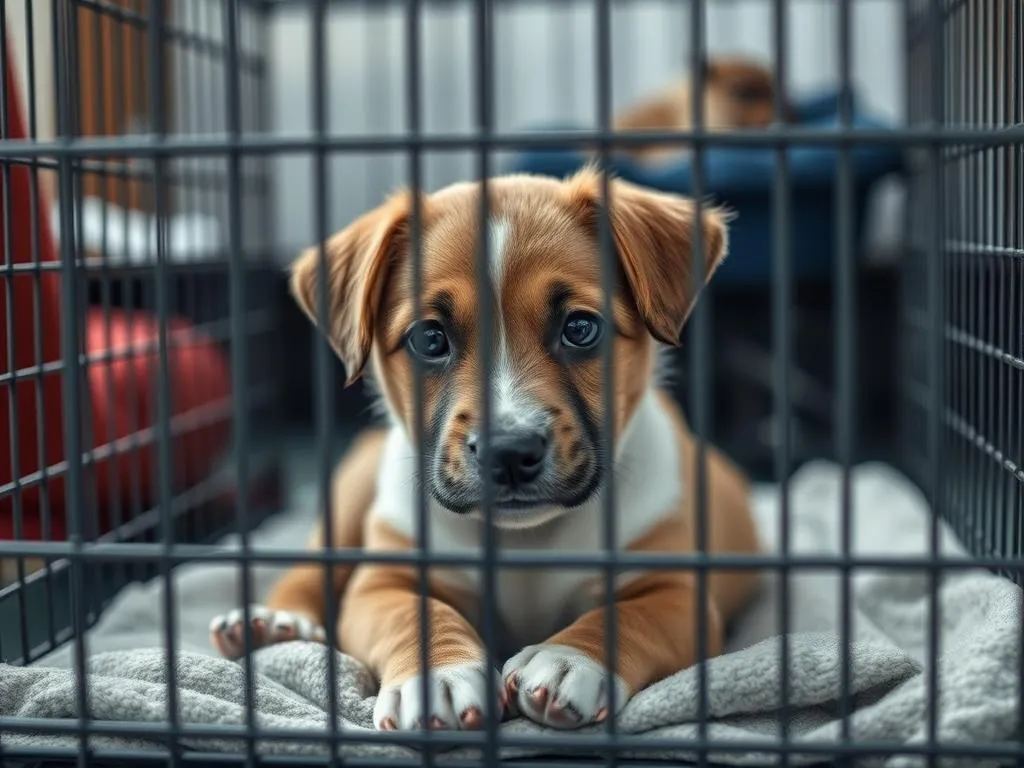
When you first introduce your new puppy to their crate, you might envision a peaceful scene: your puppy happily curling up in their cozy space, feeling secure and content. Instead, you might find yourself facing a much different reality—your puppy hates the crate, whining, barking, and scratching at the door. This scenario can be frustrating for any puppy owner, but understanding and addressing crate aversion is essential for a harmonious household.
Crate training is not just about keeping your puppy contained; it serves numerous purposes that contribute to the well-being of both the puppy and the owner. A crate can be a safe haven for your furry friend, a space where they can feel secure, and a tool for effective house training. In this blog post, we will explore the roots of crate anxiety, the importance of proper crate training, and practical steps you can take to help your puppy love their crate.
Understanding Crate Anxiety
Crate anxiety refers to the distress some puppies feel when confined to a crate. This anxiety can manifest in various ways, making it essential for owners to recognize and address these behaviors early on.
Common Signs of Crate Aversion
Puppies express their discomfort in several ways:
- Whining: A common response when your puppy feels anxious or lonely.
- Barking: Vocalizing frustration or a desire to escape.
- Scratching: Attempting to get out of the crate.
- Refusal to Enter: Your puppy may outright decline to go inside the crate, indicating their aversion.
Recognizing these signs is the first step to helping your puppy feel more at ease with their crate.
Reasons Why Puppies Hate the Crate
Understanding the reasons behind your puppy’s aversion to the crate can help you tackle the issue effectively.
-
Previous Negative Experiences: If your puppy has had a bad experience related to confinement, they may associate the crate with fear or discomfort.
-
Lack of Proper Introduction: Gradual introductions are crucial. If your puppy was forced into the crate too quickly, they may develop a dislike for it.
-
Isolation and Confinement: Dogs are social creatures. Too much time alone in a crate can lead to feelings of loneliness and anxiety.
-
Physical Discomfort: An uncomfortable crate can exacerbate negative feelings. Issues such as size, bedding quality, and ventilation can all influence your puppy’s experience.
The Importance of Proper Crate Training
Effective crate training has numerous benefits for both you and your puppy.
-
Safety: A crate keeps your puppy safe when you cannot supervise them, preventing accidents and harmful situations.
-
Security: With proper training, a crate becomes a secure space for your puppy, reducing anxiety and providing a sense of comfort.
-
House Training: Crates can aid in house training by teaching puppies to hold their bladder and bowels until they are let outside.
Transforming the crate into a positive environment is key to overcoming crate aversion.
Steps to Help Your Puppy Love the Crate
Choose the Right Crate
Selecting the appropriate crate for your puppy is essential. Consider the following:
-
Size and Type: Choose a crate that accommodates your puppy’s breed and size. It should be spacious enough for them to stand up, turn around, and lie down comfortably.
-
Comfort Features: Look for crates with proper ventilation and consider adding soft bedding and toys to enhance comfort.
Gradual Introduction to the Crate
A gradual introduction can significantly impact how your puppy perceives their crate.
-
Familiarization with the Crate: Start by leaving the crate open and allowing your puppy to explore it freely. Place treats inside to encourage them to enter.
-
Positive Reinforcement Techniques: Use treats and praise liberally when your puppy shows interest in the crate. This helps create positive associations.
Short Crate Sessions
Begin crate training with short sessions to ease your puppy into the process.
-
Start with Short Intervals: Initially, confine your puppy for just a few minutes at a time, gradually extending the duration as they become more comfortable.
-
Monitor and Adjust: Pay attention to your puppy’s behavior. If they show signs of distress, you may need to reduce the crate time or take a step back in the training process.
Create a Positive Environment
Making the crate an inviting space is vital for successful training.
-
Add Comfort Items: Include favorite toys or a blanket that smells like you to help your puppy feel more at home.
-
Use of Calming Aids: Consider using pheromone diffusers or calming sprays designed for dogs to reduce anxiety.
Establish a Routine
Consistency is crucial in crate training.
-
Consistency is Key: Develop a regular schedule for crate time, incorporating it into your daily routine.
-
Incorporate Crate Time into Daily Activities: Integrate crate time with play and mealtime, allowing your puppy to associate it with positive experiences.
Troubleshooting Common Issues
Even with the best intentions, you may encounter challenges as you work to help your puppy love the crate.
Excessive Barking or Whining
If your puppy is vocalizing excessively, it’s important to understand their behavior.
-
Understanding the Behavior: Some barking or whining is normal, especially during the initial training phase. However, persistent vocalization can indicate anxiety.
-
Strategies to Address Vocalization: Gradually increase crate time, and avoid responding immediately to their cries, as this could reinforce the behavior.
Refusal to Enter the Crate
If your puppy refuses to enter the crate, it’s essential to assess the underlying reasons.
-
Assessing the Reasons for Refusal: Analyze your puppy’s body language and stress levels. They may be scared or uncomfortable.
-
Creative Solutions to Encourage Entry: Use games or incentives, such as tossing treats into the crate, to make entering feel like a fun, rewarding experience.
Crate Escape Artists
Some puppies may attempt to escape from their crate, which can be concerning.
-
Identifying Escape Behaviors: Look for signs of your puppy trying to escape, such as digging or scratching at the door.
-
Securing the Crate: Ensure the crate is appropriately secured. You might consider using a crate with a more robust locking mechanism or even a different type of crate altogether.
When to Seek Professional Help
If your puppy’s crate aversion persists despite your best efforts, it may be time to consult a professional.
-
Signs It’s Time to Consult a Trainer: If your puppy’s anxiety or fear seems extreme or unmanageable, seeking expert guidance can help.
-
Finding a Qualified Trainer: Look for trainers who specialize in behavior modification and use positive reinforcement techniques.
Conclusion
Crate training can be a game-changer for both you and your puppy. By understanding the roots of their aversion and implementing effective training strategies, you can help your puppy feel safe and secure in their crate. Remember, patience and consistency are key. With time, your puppy can learn to love their crate, transforming it into a cozy retreat rather than a source of stress.
By embracing the crate training process, you are investing in a happier, more well-adjusted puppy. So take a deep breath, stay positive, and enjoy the journey of training your puppy to love their crate.









